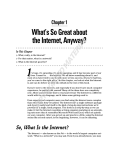Download Wiley The Internet For Dummies, 13th Edition
Transcript
Chapter 1 RI AL What’s So Great about the Internet? TE In This Chapter ▶ What, really, is the Internet? MA ▶ For that matter, what is a network? ▶ What is the Internet good for? D I GH TE t’s huge, it’s sprawling, it’s globe spanning, and it has become part of our lives. It must be . . . the Internet. We all know something about it, and most of us have tried to use it, with more or less success. (If you’ve had less, you’ve come to the right place.) In this chapter, we look at what the Internet is and can do, before we dive into details in the rest of this book. PY RI If you’re new to the Internet, and especially if you don’t have much computer experience, be patient with yourself. Many of the ideas here are completely new. Allow yourself some time to read and reread. The Internet is a different world with its own language, and it takes some getting used to. CO Even experienced computer users can find using the Internet more complex than other tasks they’ve tackled. The Internet isn’t a single software package and doesn’t easily lend itself to the kind of step-by-step instructions we’d provide for a single, fixed program. This book is as step-by-step as we can make it, but the Internet resembles a living organism mutating at an astonishing rate more than it resembles Microsoft Word and Excel, which sit quietly on your computer. After you get set up and practice a little, using the Internet seems like second nature; in the beginning, however, it can be daunting. 10 Part I: Welcome to the Internet So What Is the Internet? The Internet — also known as the Net — is the world’s largest computer network. “What is a network?” you may ask. Even if you already know, you may want to read the next couple of paragraphs to make sure that we’re speaking the same language. A computer network is a bunch of computers that communicate with each other, sort of like a radio or TV network connects a bunch of radio or TV stations so that they can share the latest episode of American Idol. Don’t take the analogy too far. In broadcast networking, TV networks send the same information to all stations at the same time; in computer networking, each particular message is routed to a particular computer, so different computers can display different things. Unlike TV networks, computer networks are two-way: When computer A sends a message to computer B, B can send a reply back to A. Some computer networks consist of a central computer and a bunch of remote stations that report to it (for example, a central airline-reservation computer with thousands of screens and keyboards in airports and travel agencies). Other networks, including the Internet, are more egalitarian and permit any computer on the network to communicate with any other computer. Many wireless devices — the cellphone, Palm handheld, BlackBerry, iPhone, and their ilk — expand the reach of the Internet right into our pockets. (Hands off our wallets!) The Internet isn’t simply one network — it’s a network of networks, all freely exchanging information. The networks range from the big, corporate networks to tiny ones (such as the one John built in his back bedroom, made from a couple of old PCs he bought at an electronics parts store) and everything in between. College and university networks have long been part of the Internet, and now high schools and elementary schools are joining in. Lately, the Internet has become so popular that many households have more than one computer and are creating their own little networks that they connect to the Internet. What’s All the Hoopla? Everywhere you turn, you can find traces of the Internet. Household products, business cards, radio shows, and movie credits list their website addresses (usually starting with www and ending with “dot com”) and their e-mail addresses. New people you meet would rather give you an e-mail address than a phone number. Everyone seems to be “going online” and “googling it.” Chapter 1: What’s So Great about the Internet The Internet affects our lives on a scale as significant as the telephone and television. When it comes to spreading information, the Internet is the most significant invention since the printing press. If you use a telephone, write letters, read a newspaper or magazine, or do business or any kind of research, the Internet can radically alter your worldview. On networks, size counts a great deal: The larger a network is, the more stuff it has to offer. Because the Internet is the world’s largest interconnected group of computer networks, it has an amazing array of information to offer. When people talk about the Internet, they usually talk about what they can do, what they have found, and whom they have met. The number of available services is too huge to list in this chapter, but here are the Big Three: ✓ Electronic mail (e-mail): This service is certainly the most widely used — you can exchange e-mail with millions of people all over the world. People use e-mail for anything for which they might use paper (mail, faxes, special delivery of documents) or the telephone (gossip, recipes, love letters) to communicate — you name it. We hear that some people even use it for stuff related to work. Electronic mailing lists enable you to join group discussions with people who have similar interests and to meet people over the Net. Part IV of this book has all the details. ✓ The World Wide Web: When people talk these days about surfing the Net, they often mean checking out sites on this (buzzword alert) global multimedia hyperlinked database. In fact, people are talking more about the web and less about the Net. Are they the same thing? Technically, the answer is “No.” But practically speaking, the answer for many people is “Pretty close.” We tell you the truth, the whole truth, and nothing but the truth in Part III of this book. Websites can provide you with information ranging from travel information to how to raise chickens. You can also look at videos, listen to music, buy stuff, sell stuff, and play video games. The software used to navigate the web is a browser. The most popular browsers now are Firefox, Google Chrome, and Internet Explorer. We tell you all about them in Chapter 6. ✓ Instant messaging (IM’ing): Programs such as Windows Live Messenger, Yahoo! Messenger, and AOL Instant Messenger let you send messages that “pop up” on the recipient’s screen. We hear tales of nimble-fingered youth carrying on upward of 13 IM sessions simultaneously. Some websites also provide messaging services. We tell you about IM programs in Chapter 12. The Internet is unlike any other communications media we’ve ever encountered. People of all ages, colors, creeds, and countries freely share ideas, stories, data, opinions, and products. 11 12 Part I: Welcome to the Internet Does the Internet truly reach every continent? Some skeptical readers, after reading the claim that the Internet spans every continent, may point out that Antarctica is a continent, even though its population consists largely of penguins, who (as far as we know) aren’t interested in computer networks. Does the Internet go there? It does. A few machines at the Scott Base on McMurdo Sound in Antarctica are on the Internet, connected by radio link to New Zealand. The base at the South Pole has a link to the United States. See the polar webcam at www.usap.gov. At the time we wrote this book, the largest Internet-free land mass in the world was probably an uninhabited island in the Canadian arctic — Devon Island, perhaps. (You can look it up on the Internet.) Even there, a satellite connection can provide an Internet connection, so perhaps nowhere on the surface of the earth is truly Internet-free. Anybody can access it One great thing about the Internet is that it’s the most open network in the world. Thousands of computers provide facilities that are available to anyone who has Internet access. Although pay services exist (and more are added every day), most Internet services are free for the taking after you’re online. If you don’t already have access to the Internet by way of your company, your school, your library, or a friend, you can pay for access by using an Internet service provider (ISP). We talk about some ISPs in Chapter 4. One significant change in Net use in the past few years has been the move to ever smaller, lighter, and cheaper equipment to connect to it. A netbook is a small, inexpensive computer, about the size and weight of this book, that’s intended mainly for connecting to the Net. If a netbook is too big for you, a smartphone such as the Apple iPhone or one using Google Android puts a computer, and the Internet, in your pocket with an always-on connection. It’s politically, socially, and religiously correct Another great thing about the Internet is that it is what one may call “socially unstratified.” That is, one computer is no better than any other, and no person is any better than any other. Who you are on the Internet depends solely on how you present yourself when you’re using your computer. If what you say makes you sound like an intelligent, interesting person, that’s who you are. It doesn’t matter how old you are or what you look like or whether you’re a student, business executive, or construction Chapter 1: What’s So Great about the Internet worker. Physical disabilities don’t matter — we correspond with deaf and blind people. If they hadn’t felt like telling us, we never would have known. People become famous (and infamous) in the Internet community as a result of their own efforts. The Net advantage The Internet has become totally mainstream, and you’re falling further behind the curve — and at a faster rate — if you haven’t yet gotten started. Increasingly, news gets out on the Internet before it’s available any other way, and the cyberdeprived are losing ground. Cloudy with a chance of servers Computers these days are very, very fast — so fast that they have far more processor power than they can use. (Your computer is drawing shimmery, semitranslucent, animated borders around the windows on your screen because it has nothing better to do between keystrokes.) Computer servers turn out to have the same problem — it takes a large website to keep a server busy, and servers are often idle for most of the day. It also turns out that it’s much more efficient to run many computer servers in one place, where they can share mounting racks, power, air conditioning, and fast network connections, so for many years the standard way to run a web server has been to rent space for it in a data center. But those servers are still idle most of the time. The advanced, cutting-edge virtualization technology allows one superfast server to operate as though it were many independent, reasonably fast, virtual servers and, more importantly, to start and stop virtual servers as needed. So now, someone who before would have owned or rented a few physical computers can now ask a data center to start up virtual servers when they’re needed and stop them when they aren’t. Because different virtual servers are busy at different times, this situation tends to even out the load, particularly when a company is big enough to have data centers in several parts of the world; people in Europe are using their virtual servers while Californians are asleep, and vice versa. A name such as demand-allocated, geographically distributed virtual servers isn’t snappy enough, so they call it cloud computing instead. From a user’s point of view, no difference exists between a website run in cloud and one run any other way, but cloud computing enables website operators to run a substantial web operation and not have to buy server equipment or even know the exact locations of the servers they’re using. Cloud providers tend to be big companies that already have big data centers — notably, Amazon and Microsoft. (John uses the Amazon cloud service and believes that his data is probably somewhere near Seattle. The website Margy manages, www.uua.org, lives in a cloud over Virginia.) Fun historical fact: Virtualization was invented by IBM researchers in 1967, and mainframe computers have used it for four decades, so maybe it’s not all that cutting-edge. But don’t tell cloud enthusiasts or else you’ll hurt their feelings. 13 14 Part I: Welcome to the Internet Here are some of the ways people use the Internet: ✓ Find information: Many websites have information free for the taking. It ranges from IRS tax forms that you can print and use to help-wanted ads, real estate listings, and recipes. From U.S. Supreme Court decisions and library card catalogs to the text of old books, digitized pictures (many suitable for family audiences), and an enormous variety of software — from games to operating systems — you can find virtually anything on the Net. You can check the weather forecast, view movie listings, find your childhood sweetheart, browse catalogs, and see school closings for anywhere in the world, from anywhere in the world. Special tools known as search engines and directories help you find information (and people) on the web. See Chapter 13 to find out how to search for the information you need. ✓ Stay in touch: Weblogs (or blogs) let people and organizations distribute current information about themselves rapidly and easily. Microblogs, such as Twitter, combine the Net with mobile phone text messages to let people stay up to date anywhere, at any time. ✓ Get an education: Schoolteachers coordinate projects with classrooms all over the globe. College students and their families exchange e-mail to facilitate letter-writing and keep down the cost of phone calls. Students do research from their home computers. The latest encyclopedias are online. ✓ Buy and sell stuff: On the Internet, you can buy anything from books about beermaking to stock in microbreweries. And you can make some cash by cleaning out your closets and selling your old junk on eBay. Software companies sell software and provide updates on the Net. Most software distribution is migrating to the Internet, where a customer can download and install programs without waiting for a CD to arrive. We talk about the relevant issues in Chapter 15. ✓ Travel: Cities, towns, states, and countries are using the web to put up (or post) tourist and event information. Travelers find weather information, maps, and museum hours as well as plane, train, and bus schedules and tickets. While you’re at it, you can buy your airplane tickets, rent a car, and make hotel reservations. ✓ Use intranets: Businesses have figured out that this Internet concept is truly useful, and they create their own, private networks — like miniInternets. On these intranets, companies use web pages for posting company information such as benefits, filing expense reports and time sheets, and ordering supplies. An intranet helps an organization provide information that employees can see from inside the company that folks on the outside can’t see, including manuals, forms, videos of boring meetings, and, of course, endless memos. In some organizations, e-mail and intranets reduce the amount of paper wasted on this stuff. ✓ Play games: Internet-based multiuser games can easily absorb all your waking hours and an alarming number of what would otherwise be your Chapter 1: What’s So Great about the Internet sleeping hours. You can challenge other players who can be anywhere in the world. Many kinds of games are available on the web, including such traditionally addictive games as bridge, hearts, chess, checkers, and go. In Chapter 20, we tell you where to find these games. ✓ Find love: People are finding romance on the Net. Singles ads and matchmaking sites vie for users. The Internet long ago grew beyond the original bunch of socially challenged, 22-year-old, nerdy guys and now has turned into the world’s biggest matchmaker, for people of all ages, genders, preferences, and life situations. ✓ Heal: Patients and doctors keep up to date with the latest medical findings, share treatment experience, and support one another around medical problems. We even know of some practitioners who exchange e-mail directly with their patients. ✓ Invest: People research financial information, buy stock, and invest money online, as we tell you about in Chapter 16. Some online companies trade their own shares. Investors are finding new ventures, and new ventures are finding capital. ✓ Participate in nonprofits: Churches, synagogues, mosques, schools, clubs, teen centers, and other community organizations post pages telling web users about themselves and inviting new people. The online church newsletter always arrives before Sunday. Where did the Internet come from? The ancestor of the Internet is the ARPANET, a project funded by the Department of Defense (DoD) in 1969, as an experiment in reliable networking and to link DoD and military research contractors, including many universities doing military-funded research. (ARPA stands for Advanced Research Projects Administration, the branch of the DoD in charge of handing out grant money. For enhanced confusion, the agency is now known as DARPA — the added D is for Defense, in case anyone wondered where the money came from.) Although the ARPANET started small — connecting three computers in California with one in Utah — it quickly grew to span the continent and, via radio link, Europe. In the early 1980s, the ARPANET grew into the early Internet, a group of interlinked networks connecting many educational and research sites funded by the National Science Foundation (NSF), along with the original military sites. By 1990, it was clear that the Internet was here to stay, and DARPA and the NSF bowed out in favor of the commercially run networks that make up today’s Internet. (And, yes, although Al Gore didn’t invent the Internet, he was instrumental in keeping it funded so that it could turn into the Internet we know now.) Familiar companies such as AT&T, Comcast, Sprint, and Verizon run some networks; others belong to specialty companies, such as Level3 and Cogent. No matter which one you’re attached to, they all interconnect, so it’s all one giant Internet. For more information, read our web page at http://net.gurus.org/ history. 15 16 Part I: Welcome to the Internet Okay, What Next? If you’re ready to jump on the Internet, first read Chapter 2 for some safety tips. If you have children (or grandchildren), read Chapter 3 about what kids should (and shouldn’t) do online. Done? Chapter 4 tells you how to get connected! Turn off the computer now and then We can tell you from experience that when you’re on the Net, the hands on the clock slow down and stop and you can spend more time online than you can imagine. For some people, it’s impossible to go ten minutes without checking e-mail, dirty dishes are ignored while visiting “just one more” web page, and they reach the point of possibly having an Internet addiction. Remember that the Net is a fine adjunct to real life — not a substitute. As our friend and longtime Net user Jean Polly regularly says: The Internet is closing! Go outside and play!



















